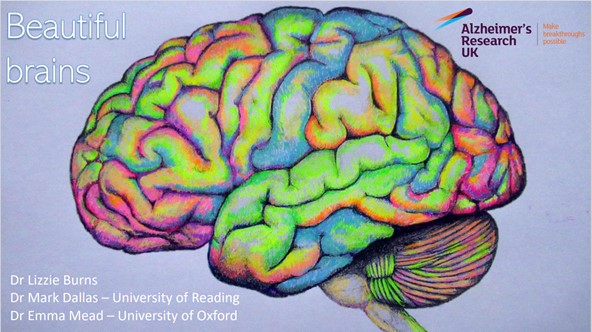Dr Mark Dallas from Pharmacy explains how he has enlisted the skills of an artist to bring the wonders of neuroscience to schoolchildren.

The brain is an amazing organ that makes you who you are (although admittedly I am biased because I am a neuroscientist). An army of scientists across the globe are trying to uncover its hidden secrets and understand what goes wrong with our brains to cause brain disease, such as Alzheimer’s.
Given their complexity and that there is so much still to discover about brains, you can imagine the difficulty of trying to convey the wonders of brain science to 7- to 17-year-old students. This younger audience often feel that brains are too complicated and this presents a barrier to sharing brain science with them. I have become a keen science communicator through my engagement with dementia charities but even I needed help. Luckily for me, scientist-turned-artist Dr Lizzie Burns was up for the challenge and secured one of the first Alzheimer’s Research UK Inspire Fund public engagement awards to work with brain scientists like me to create a host of resources aged at a younger audience.
Creative art has a way of opening doors to complex scientific theories and making them accessible to all and it supports getting students to be active in science. As a scientist it is often hard to communicate the wonders of our brains without imagery, and the usual stock images are often static and do not engage younger audiences. Dr Lizzie Burns took my team’s research, alongside the research of colleagues at the University of Oxford, and reimagined it. She developed imagery and art resources that allow students to get hands-on with neuroscience and see what our brains look and feel like.
The project hasn’t just benefited schoolchildren. I have found the process of transforming our brain research into creative artwork and activities has opened new ways of interpreting my science. It has also given me a shared appreciation of creative art and helped me to realise that it is not that far removed from science. Scientists and artists have a similar desire to see the world in new ways and to share their visions with others. This mutual passion for disseminating our work drives the exploration of new techniques and ways of working.
For example, Lizzie and I came up with the idea that origami could be used to show the elegant yet complicated way in which proteins fold in our bodies. This opens up an appreciation of complex protein structures and also provided a hands-on approach to science through art. Here is a video of what we came up with:
So I would encourage all scientists to delve into their creative side and take a creative approach to reimagining their research area. If you’re struggling, help is always at hand with a range of funding options for you to build partnerships with artists (e.g. Alzheimer’s Research UK Inspire Fund). If successful, these approaches can not only deliver great outreach resources that will support in-class activities but they also allow us as scientists to strip back the complex biological processes that we explore on a daily basis and make them fun for those keen to explore science. This surely is part of our mission as scientists, although all too often it slips off our priority list because of all the other demands on our time. An added bonus is that the images created are also useful tools for that next talk or presentation, allowing you to avoid using the same old uninspiring stock images.
I went into this project without any real expectations and hoped for useful material to help break down barriers for students to engage in neuroscience. But what I got was more than this, in that it provided me with a real sense of how I could use art in my future science communication endeavours to help everyone to imagine my research. Through this project I believe the French poet Jean Cocteau go it right when he said; “Art is science made clear”. I hope that the students who use the resources will agree.
Learn more about the Beautiful Brains project
See the Beautiful Brains ‘Creative cells’ resources for kids on the Alzheimer’s Research UK website
Watch a video of Mark and Lizzie talking about brain cells
Find out more about public engagement with research on our website
